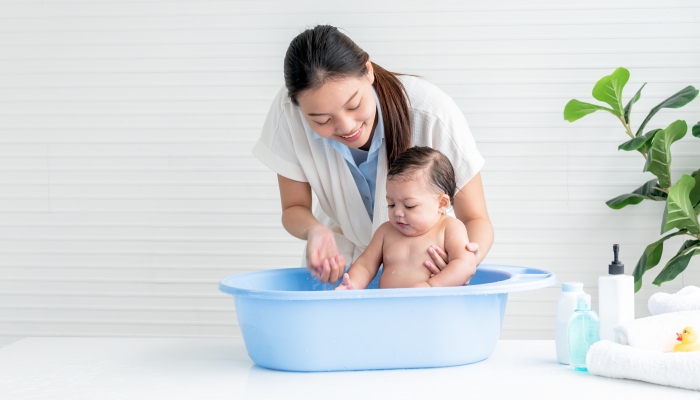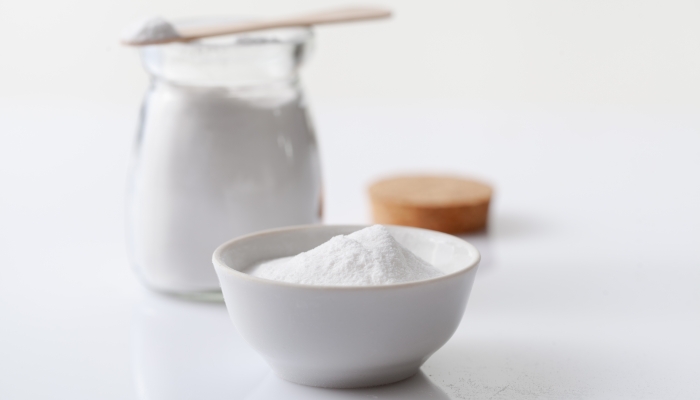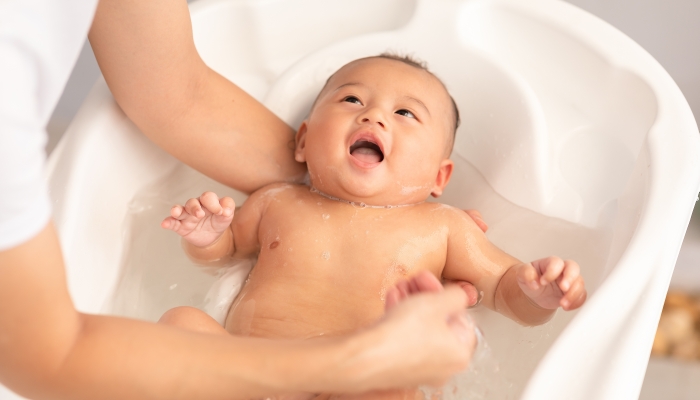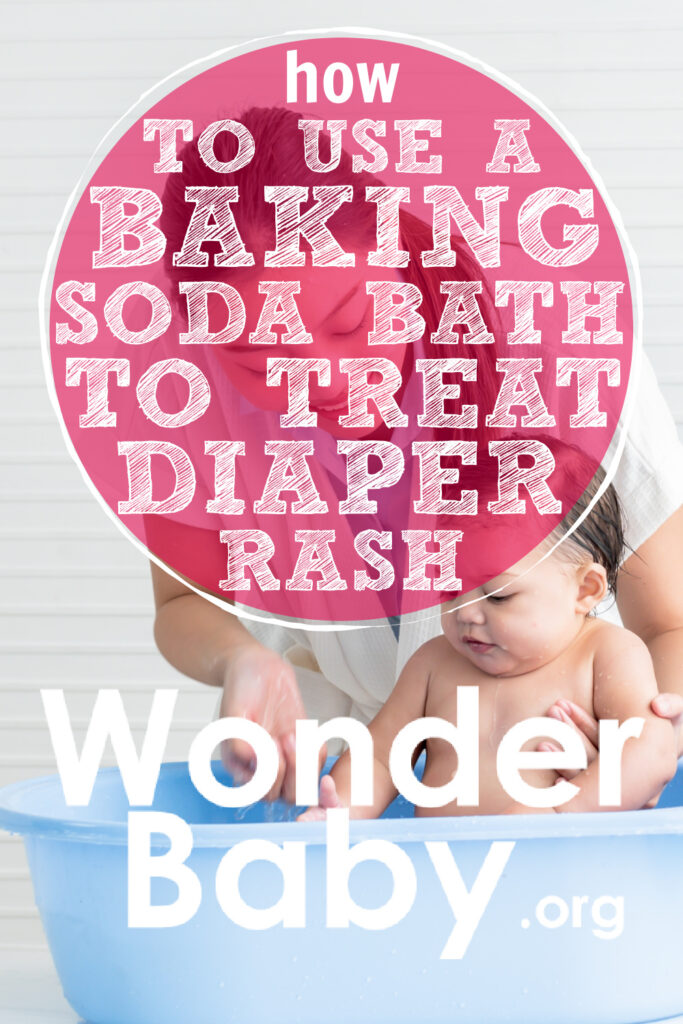How to Use a Baking Soda Bath to Treat Diaper Rash

- Diaper rash is a common problem among newborn infants.
- Diaper rash cream works well, but it can be expensive.
- A baking soda bath is a great alternative to using diaper rash cream for your baby’s sensitive skin.
Every baby is bound to get a diaper rash at some point during infancy. The combination of sensitive skin and moisture from soiled diapers is a perfect recipe for diaper rash. Diaper rashes also tend to get worse during teething, when your baby starts sleeping longer stretches at night, or when they have an illness.
It’s nearly impossible to keep your child’s skin dry at all times, which can make it difficult to heal diaper rash. Fortunately, there are simple methods like using a baking soda bath for diaper rash to soothe itchy skin and give your baby relief.
Baking Soda Bath to Treat Diaper Rash: Is It Effective?
According to Susan Boiko, MD, in the article Treatment of Diaper Dermatitis published in Dermatologic Clinics, diaper rash is one of the most common conditions that affects infants.
Despite it being a common condition, parents still worry about treating their little one’s skin. There are hundreds of products available for parents to buy for the treatment of diaper rash, so can treatment really be as simple as adding a common household ingredient to your baby’s bath time routine?
Baking soda baths are very effective for treating diaper rash. Some mothers go as far as to call it a miracle treatment for their little one’s skin.
In addition to baking soda, you can also buy special diapers for sensitive skin or leave your baby naked as often as possible to help the area dry out.
Is a Baking Soda Bath Safe for Babies?
Baking soda baths are safe for babies as long as you only use a small amount of baking soda and make sure they do not drink the baking soda water. Seattle Children’s Hospital recommends soaking your baby’s inflamed skin in a baking soda bath for ten minutes, up to three times per day.
Baking soda baths have been used to treat baby’s skin for decades, with very few adverse reactions.

Benefits of a Baking Soda Bath for Diaper Rash
There are several benefits of using a baking soda bath for diaper rash over other potential treatments.
Inexpensive
The only ingredients you need for your baby’s baking soda baths are warm water and a little baking soda. Baking soda is inexpensive and most households already have some around the house. You can simply add a little baking soda to the water, every time you bathe your child.
Safe
Baking soda is safe to use in a warm bath or as a baking soda paste. Just make sure that your baby does not drink the bathwater after adding baking soda.
Prevents Infections
An article published in Dermatology Research and Practice shows that skin conditions like diaper rash can lead to serious infections. When a diaper rash becomes severe, open sores on the skin are vulnerable to infection. Using baking soda for treating diaper rash can keep your baby’s skin safe from a severe diaper rash and potential infection.
Research from Mycopathologia shows that baking soda has both antibacterial and antifungal properties. Because moist diaper areas are prone to yeast infections, a little dissolved baking soda in your baby’s bath is a great tool for keeping yeast and fungus away.
How to Make a Baking Soda Bath to Treat Diaper Rash
To make a baking soda bath for diaper rash, simply add 2–3 tablespoons of baking soda to a warm bath. Let your baby sit in the bath for about ten minutes, then make sure that they are completely dry before dressing them again. Use diaper cream on their irritated skin before replacing your baby’s diaper.
Adding more than a few tablespoons of baking soda to the bath will not make it more effective. In fact, adding a cup of baking soda to the warm bath water can actually put your child’s health at risk.
Important Things to Remember When Giving a Baking Soda Bath
While baking soda baths are a safe option for treating diaper rash, there are some important things to keep in mind before giving it a try to help keep your baby safe.
Bathtub Safety
Children under the age of 5 years old need constant adult supervision in the bathtub. Do not leave older children in charge of supervising younger kids in the bath.
Always check the temperature of the bath before placing your baby in the water. A lukewarm bath is best for young babies, and you should never use hot water in an infant tub.
Baking Soda is Slippery
Some parents may be surprised to find that the combination of baking soda and water on their baby’s skin makes everything incredibly slippery. You may need to use a towel instead of your bare hands to get your baby out of their baking soda bath to prevent them from slipping from your grasp.
Too Much Might Make Your Baby Sick
A report by the American Academy of Pediatrics studied a case of a four month old baby who got sick from bathing in too much sodium bicarbonate, or baking soda. His symptoms resolved when the baking soda treatments were stopped.
Use Baking Soda, Not Baking Powder
Although similar, baking soda and powder are not the same. They are both made from sodium bicarbonate, but baking powder has an acid added to it to change the composition. Baking powder will not relieve pain and itching the way baking soda does.

Other Uses for Baking Soda Baths
Baking soda is good for more than just diaper rash. Baking soda baths can be used to treat several different skin conditions.
Psoriasis
Baking soda baths have also been shown to relieve psoriasis symptoms in adults. A study published in the Journal of Dermatologic Treatment showed that adults with psoriasis had significant relief of their inflamed skin. Many of them chose to continue baking soda baths in addition to their psoriasis medicated baths after the study ended.
Exfoliating Mixture
If you want to give yourself or your baby an extra special bath, try adding oatmeal and baking soda to your warm water. An oatmeal bath can hydrate the skin, and the baking soda can act as an exfoliator to remove dead skin cells. You can add a few drops of essential oils for a pleasant smell and a truly spa-like experience.
Soothe Rash from Toxic Plants
Poison ivy and poison oak can cause a painful skin reaction. If you or your baby come in contact with one of these toxic plants, remove any clothing that may have come in contact with the plant and rinse the skin immediately.
As soon as you can, soak the affected area in lukewarm water mixed with baking soda. The bicarbonate ions in the mixture will help relieve itching and soothe the irritated skin.
FAQs
Can you put baking soda directly on the diaper rash?
For mild diaper rash, some people recommend making a paste of baking soda and water, and leaving it on until the next diaper change. Putting baking soda directly on the skin will not harm your baby, but make sure you change their diapers frequently.
For severe diaper rash, talk to your child’s pediatrician about the best treatment options.
When is the best time of the day to give your baby a baking soda bath?
You can give your baby a baking soda bath at their usual bath time, and can even soak them in a baking soda bath for ten minutes up to three times daily. Ideally, you should give your baby a baking soda bath after they have a bowel movement, since the soda bath can help buffer the acidity of your child’s stool.
Are disposable diapers or cloth diapers better for diaper rash?
Stanford Medicine states that disposable diapers may be less likely to cause diaper rash than cloth diapers. Disposable diapers tend to be more absorbent and less likely to leak than cloth diapers. Moms who prefer cloth diapers should remember to change their baby’s diaper more frequently and can use a diaper cover to prevent blowouts.
Are diaper rashes always caused by a wet diaper?
Diaper rashes are actually caused by stool, not urine. Stool is more acidic than urine, and is not as easily absorbed by a baby’s diaper. While you still need to get your baby out of a wet diaper as soon as you can, stool in a diaper is what usually leads to diaper rash, yeast infection, and urinary tract infection.

The information WonderBaby provides is not intended to be, and does not constitute, medical or other health advice or diagnosis and should not be used as such. Always consult with a qualified medical professional about your specific circumstances.
Related Posts

Eye Conditions and Syndromes, Visual Impairment
Neuralink Announces Plans to Restore Sight to the Blind with Brain Chip
Elon Musk’s company Neuralink has announced plans to begin human trials of its new “Blindsight” brain chip by the end of 2025.

Health & Nutrition
Can Baby Skin Care Products Expire?
Is that forgotten tube of diaper rash cream still safe to use? Learn more about the expiration dates of popular skin care products for infants.

Health & Nutrition
Boosting Immunity in Kids: 3 Tips for a Healthy Winter
Parents can help boost their kids’ immunity during cold and flu season by maintaining healthy eating, sleeping, and exercising habits in the winter.